ABSTRACT
This study was carried out to understand the maize value chain in Tatkon Township where this study was conducted with the analyses of the production and marketing along the maize value chain including the socio-economic conditions of the farmers and marketing margins in the study area. The farm level survey and the market intermediaries’ level survey were conducted during October-November 2014. The primary data was collected with 120 sample farmers from Nweyit and Kyathaai villages in Tatkon and 15 village brokers, 14 local wholesalers in Tatkon, one poultry farm in Tatkon and two maize exporters in Mandalay. There were three value chains in Tatkon Township. According to the comparison of these three chains, the highest profit percentage was obtained by farmers followed by Mandalay wholesalers, local wholesalers and profit percentage of village brokers as commission fees. Maize growers obtained about 70% of export price share along the maize value chain which is the reasonable profit share.
Key words: Marketing margin, value chain, and profit share.
INTRODUCTION
Maize (Zea mays l.) also known as corn, is one of the most extensively cultivated cereal crops in the world. It is also the third largest cereal crop after wheat and rice. The world maize production reached a level of 1,018.11 million MT and sown area was 185.12 million hectares in 2013 (FAOSTAT, 2013). It is mostly used and traded as an important staple food crop for both human and animals. About 73 % of the world’s maize growing areas are located in developing countries most abundantly in low and lower-middle income nations. Maize is predominantly grown under rain-fed conditions by smallholders and resource-limited farmers which showcases it as having an important role in the livelihoods of millions of poor people in Latin America, sub-Saharan Africa, and Asia (Prasanna, 2011).
In Asia, maize is the second most important cereal crop after rice. It is also the primary source of feed for the poultry and livestock industry as well as a source of raw material for the manufacturing sector. It is therefore maize which stands as an important source of income for many Asian farmers. Among the cereal crops group, maize stands the second most important crop after rice in Myanmar. Due to the important livestock and food processing industries, it is also important as substitute staple food for people in some rural areas and those living in mountainous regions. As an exportable commodity for neighboring countries, maize production is moving forward. Marketing is the most important aspect in the development process. This is obviously due to the fact that development basically means larger size production activities in the economy. But we cannot have more of production unless the goods produced are actually sold out and selling depends on the proper marketing conditions (Prasad and Prasad, 1995). Based on these prominent factors of marketing, this study was carried out to figure the role of maize production and marketing performance in the study area.
Value chain is a sequence of related business activities (functions) from provision of specific inputs for a particular product to primary production, transformation and marketing, up to the final sale of a particular product to the consumer. It also includes the set of operators performing different functions, such as producers, processors, traders and distributors of a particular product linked by a series of business transactions through which the product passes from primary producers to end-consumers. Thus, value chain actors, responsible for transmission of materials, information and/or services, share an interest in the end-product because changes in the end-market affect them both collectively and simultaneously (GTZ Value Links 2008).
Marketing margin is defined as a difference between price paid by consumers and those obtained by producers or the price of collection of marketing services (Tomek and Robinson 1990). Mendoza (1995) also explained that marketing margin measures the share of the final selling price which is captured by a particular agent in the marketing chain. It includes costs and typically, though not necessarily, some additional income.
Rationale
Tatkon Township is currently located in Nay Pyi Taw Council with a total population of 220,600. Before 2008, it was included under the Mandalay Region, which is one of the major maize growing areas. Moreover, this area is suitable for maize production due to its temperate ago-climatic and soil conditions. Tatkon Township is situated between latitude 20° 20ʹ north and east longitude 96° 30ʹ. The total land area is 180,237 hectares out of which 39,639 hectares are cultivated (DoA, 2014).
Tatkon Township, which is one of the major maize producing area in Myanmar, most of the maize crop was traded to China through Mandalay and Muse Township and only a few portion of maize was used as domestic livestock feed. Therefore, maize became the main income source not only for the farmers but also for the traders in the study area. Consequently, marketing activities are important to investigate for maize growers in this region. In the absence of well developed markets, marketing facilities, marketing efficiency, and farmers are at disadvantage by selling their increased marketable surplus to traders in the market as they get low prices.
After 1990, market-oriented economic policy was adopted and all the system started to change. At the same time the hybrid variety of maize by CP company from Thailand was introduced and maize production increased year after year. In the domestic maize marketing, price uncertainty can decrease market efficiency, responses and productivity, inadequate road infrastructure and network, in-transparency of market and price information and, lack of the consistency of weighting measurement lead to inefficient Market system. At the harvest time, farmers do not have enough storage facilities to handle and have a credit problem. So, most farmers have to sell their produce just after harvest. The main research outcome is the elaboration of understanding the maize production and current marketing chain of the study area.
RESULTS AND DISCUSSION
Socio-economic characteristics of market participants
In the study area, most of the sample farmers finished primary school level with age of around 52 years and the average years of farming experience in maize growing was 23. The mean value of total farm size was 1.84 hectares while maize sown area was 0.85 hectares. The average family size was five persons and most of the sample farm households still possessed the traditional farming tools as their productive assets (Table 1).
Table 1. Demographic characteristics of sample farmers (n=120)

Among the market intermediaries, average age of market participants were between 42 and 48 years and working experience in maize marketing of village brokers and Tatkon poultry farm was 8 years while the year range of local wholesalers and Mandalay wholesalers were 16-18 years. The average education level of the market participants were in high school and graduate level (Table 2).
Table 2. Demographic characteristics of village brokers (commission men) (n=15)

Source: Owned survey 2014
Maize value chain in Tatkon Township
The buyers of the products were mainly local wholesalers and Mandalay wholesalers (exporters). In this study, village brokers were farmers who facilitated the buying activities for local wholesalers. Tatkon poultry farm and Mandalay wholesalers (exporters) were the final link who deliver maize to final consumers in the value chain.
According to the survey results, 67 % of sample famers sold out their products to village brokers and 33 % of farmers directly sold to local wholesalers. In this study, all of the village brokers (commission men) collected the crops for local wholesalers with commission fees. Among the sample Tatkon local wholesalers, only 7 % of local wholesalers distributed to Tatkon poultry farm and 93 % of local wholesalers traded to Mandalay wholesalers (exporters). Here, Tatkon poultry farm and Mandalay wholesalers (exporters) were the last market participants along the maize value chain (Fig. 1).
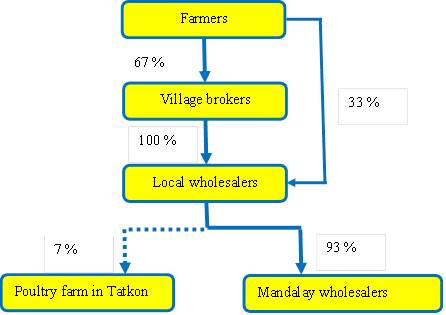
Fig. 1. Percentage of market participants along the maize value chain
Marketing margin, cost and profit of local wholesalers
According to the maize value chain, the respective marketing margin, cost and profit were calculated as the following chains in the study area.
Chain 1: Farmers → Village Brokers → Local Wholesalers → Mandalay wholesalers
Chain 2: Farmers → Local wholesalers → Mandalay wholesalers
Chain 3: Farmers → Local wholesalers → Tatkon poultry farm
Chain 1 was the main value chain including farmers, village brokers, local wholesalers and Mandalay wholesalers in the study area. The overall marketing cost and margin analysis was calculated based on one metric ton. Village collectors in the study areas served as agents of Tatkon Township wholesalers because of maize price fluctuation and lack of capital investment. Marketing margin, cost and profit of local wholesalers for channel 1 were presented in Table 3. In the first chain, buying price of local wholesalers was 208,000 Myanmar Kyats (MMK) while selling price of maize received by 249,333 MMK. Marketing margin of local wholesalers was 41,333 MMK. Marketing functions of local wholesalers included transportation, packaging, labor and cost for commission men. By summing up the costs of these market activities mentioned above the total marketing cost of 24.200 MMK was obtained. Among the total marketing cost, transportation was the highest cost per metric ton of maize traded from Tatkon to Mandalay. Therefore, the net profit of local wholesalers was 17,133 MMK. In the second chain, there was no link between farmers and village brokers because some local wholesalers purchased directly from farmers. In this calculation, marketing margin of local wholesalers was 41,333 MMK. Average total marketing costs was 22,000 MMK counting such as transportation, packaging and labor costs. Hence, net profit obtained by local wholesalers was 19,333 MMK. According to the comparison of these two channels, the profit received by local wholesalers of chain two was relatively higher than local wholesalers from chainone. This is due to the costs for commission agents (Table 4). Marketing margin, cost and profit of local wholesalers for chain three were described in Table 5. In this portion, there was no marketing link between local wholesalers and Mandalay wholesalers because some local wholesalers distributed maize in Tatkon poultry farm. Purchasing maize price of local wholesalers was 208,000 MMK even as selling price obtained by local wholesalers of 226,667 MMK. Marketing margin of local wholesalers determined by the difference between these two prices. Total marketing cost of local wholesalers of 2,200 MMK including only labor cost were observed. Net profit of local wholesalers received was 16,467 MMK.
Table 3. Marketing margin, cost and profit of local wholesalers for chain 1
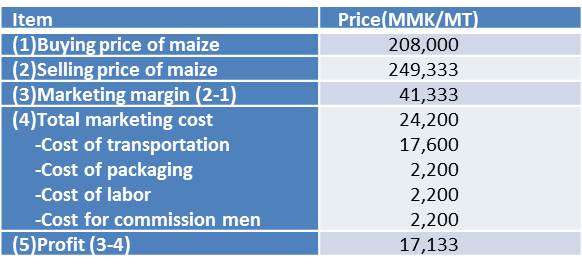
Table 4. Marketing margin, cost and profit of local wholesalers for chain 2
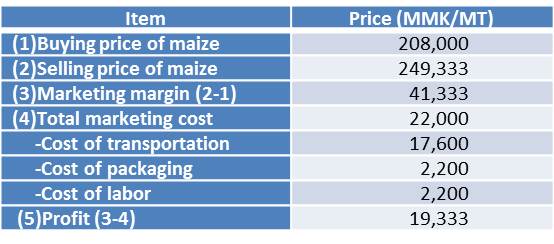
Table 5. Marketing margin, cost and profit of local wholesalers for chain 3
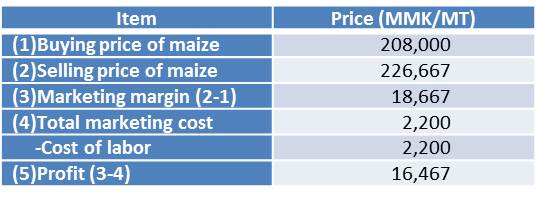
Marketing margin, cost and profit of Mandalay wholesalers (exporters)
The marketing margin, cost and profit of Mandalay wholesalers (exporters) were as presented in Table 6. Mandalay wholesalers’ buying price was 249,333 MMK whereas selling price received by Mandalay wholesalers (exporters) of 300,000 MMK. The results showed that marketing margin of Mandalay wholesalers (exporters) was 50,667 MMK per metric ton of maize. Total marketing costs of Mandalay wholesalers (exporters) was 31,200 MMK including transportation (30,000 MMK) and (labor cost 1,200 MMK). Transportation cost was very high for Mandalay wholesalers because they traded from Mandalay to Muse. Thus, the net profit of Mandalay wholesalers (exporters) was 19,467 MMK. Among the three chains, the higher profit was received by Mandalay wholesalers than local wholesalers.
Table 6. Marketing margin, cost and profit of Mandalay wholesalers (exporters)
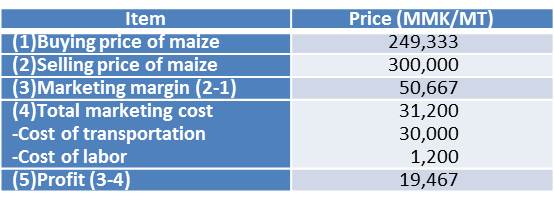
Comparison of percent composition among the market participants
It was interesting to compare the percent composition profit in sharing for each market participants along the maize value chain.
In chain one village brokers were involved as commission agents. The share of percentage difference between export and farm gate price was called total gross marketing margin which was about 30.67 %. Price received by farmers was 69.33 % in which total production costs of farmers was 34.18 % while profit obtained by farmers was 35.15 %. Marketing margin of local wholesalers was 13.78 % in which total marketing cost of 8.07 % and profit of 5.71 %. Marketing margin of Mandalay wholesalers (exporters) was 16.89 % whereas marketing cost of 10.4 % and profit 6.49 %.
In chain two, composition of farm gate price to the export price was around 69.33 % at the same time total gross marketing margin composition was 30.67 %. Total production costs of farmers found to be 34.18 % as well as profit obtained by farmers (about 35.15 %). Marketing margin of local wholesalers was 13.78 % while marketing cost of 7.34 % and profit of 6.44 % was observed. Marketing margin, cost and profit of Mandalay wholesalers (exporters) were 16.89 %, 10.4 %and 6.49 % respectively. Among the market participants from chains one and two, it was clear that the highest profit percent obtained by farmers followed by Mandalay wholesalers, local wholesalers and profit percent of village brokers as commission fees.
Table 7 evaluated that percent composition based on export price for chain three. In this calculation, Price received by farmers was 69.33 % in which total production costs of farmers was 34.18 % while profit obtained by farmers was 35.15 %. Marketing margin of local wholesalers observed 6.22 % together with marketing cost of 0.73 % and profit of 5.49 % in which 24.45 % was opportunity cost for market participants along the maize value chain. Based on the findings, it can be seen that among the three chains, the farmers got the highest profit percent received by Mandalay wholesalers (exporters). Comparison on percent profit share of market participants was shown in Table 8.
Table 7. Percent composition on export price for chain 3

Table 8. Comparison on percent profit share of market participants

Fig. 2 indicated that cost and profit composition of market participants along the maize value chain. According to the first chain, total production cost of farmers was 34.18 % and farmers obtained about 35.15 % profit share, total marketing cost of local wholesalers with village brokers (commission men) was 8.07 % in which involved commission fee for village brokers and local wholesalers received 5.71 % profit share and total marketing cost of Mandalay wholesalers (exporters) was 10.4 % and Mandalay wholesalers (exporters) received 6.49 % profit share. Chain two indicated that total production cost of farmers was 34.18 % and farmers obtained about 35.15 % profit share, total marketing cost of local wholesalers was 7.34 % and local wholesalers received 6.44 % profit share and total marketing cost of Mandalay wholesalers (exporters) was 10.4 % and Mandalay wholesalers received 6.49 % profit share. According to the last chain, total production cost of farmers was 34.18 % and farmers obtained about 35.15 % profit share and total marketing cost of local wholesalers was 0.73 % and local wholesalers received 5.49 % profit share.
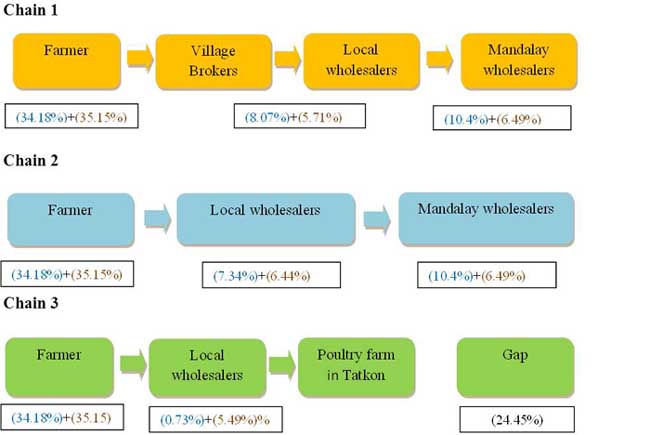
Note: blue is cost and brown is profit (%)
Fig. 2. Cost and profit composition of market participants along the maize value chain
General constraints of maize production faced by sample farmers in the study area
Major constraints mentioned by the sample farmers were small land access, poor soil condition, poor quality seeds, high input cost, low farm gate price and high transportation of crops from field to home. Among them, over 80% of sample farmers complained about the high input cost and low farm gate price. In the case of natural resource problems, 31% of sample farmers possessed small land, poor soil condition (4 %) and (2 %) of sample farmers cultivated poor quality seed. About 28% of sample farmers faced high transportation cost from field to home (Fig. 3).
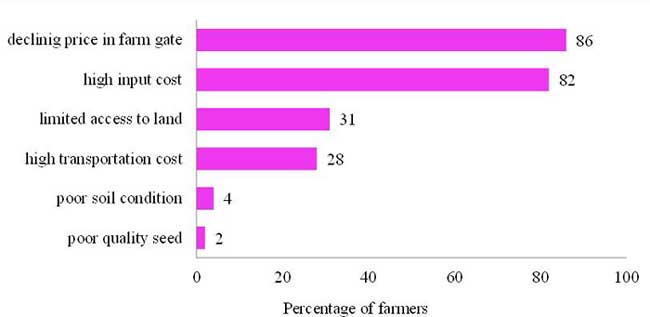
Fig. 3. General constraints raised by sample farmers
CONCLUSION
This study is carried to understand the maize value chain and farmers’ livelihood in Tatkon Township. Value chain analysis helps to identify the activities and value analysis of the produce to the consumers and how this value can be maximized. Moreover, maize is high priority crop after rice. Therefore, government promotes the production of maize for export and for animal feed, and for food security in some area. Thus, this study can fulfill the partial requirement of the smothering of the maize value chain in Myanmar.
The result showed that almost all of the maize growers were primary level graduates and they had good farming experiences The sample farmers grow maize on their own farms. They used irrigation for their maize fields and depend on weather conditions. Most farmers usually sell their products immediately after harvest with low price to the village brokers who buy maize to the farmers.
Along the maize value chain, the middle men such as the primary village collectors, local wholesalers, local poultry farm and Mandalay wholesalers have an important participation in the distribution of crops. The collectors collected the crops at the harvesting season and serve as commission agents for the town wholesalers and using the direct payment system. The town wholesalers also buy maize directly from farmers. The truck mainly used for the transportation of crops in this area. From the value chain analysis, most of the maize is flowing from farmers to export market to China. The farmers have the lowest market power in the value chain because they sold the maize with low price at harvest time. The problems faced by marketing intermediaries in the study area are the limitation of working capital, storage facilities, poor communication infrastructure and inefficient market information system. Also they have to introduce, promote and adjust export and import programs for agricultural products and enhancing the collaboration among ministries for the improvement of marketing and trade policy. The high transportation cost is one of the main constraints in Myanmar. Because of inefficient transportation system, the product price goes up and down depending on the producing season.
Policy Implication
According to the research findings, most of the sample farmers found that fertilizer application to maize seemed inefficient. It is a well known fact that, maize is heavy eater of fertilizer than other crops; efficient fertilizer application methods should be introduced. Advanced and modernized maize production technologies should be applied in the study area. Moreover, various ways of research and development programs should be driven because of its high potential yield in the study area. The agricultural extension system can enhance with well trained extension workers by uplifting the knowledge skills related to maize production. The lack of capital investment for maize growing farmers is the major problem in production and marketing. Most of the farmers do not have financial resources for input purchasing and storage facilities. Farmers sold their products immediately after harvest even with low price of maize. The special loan for maize farmers or contract farming system should be provided to the farmers.
In Myanmar, market-oriented economy has been introduced in 1988. Still changing to the market economy, the development of market institution and infrastructure and information system need to be developed. As a result, producers receive low price and consumers pay high price. In the real economy, the agricultural markets are the basic factor to increase efficiency in production and marketing. To raise the maize sector, the farmers, private traders and the government are the main actors. Government should support the efficient market system and upgrade the marketing facilities, infrastructure development and make sure that there is a well-organized market information system. This study showed there was a lower marketing margin from farmers to local poultry farm in the study area indicating the policy makers need to encourage the domestic small enterprise in order to reduce the import livestock feed from outside of the country. In addition, the high transportation cost in the marketing chain is one of the main obstacles in Myanmar. Because of the inefficient transportation system, the price goes up and down. Also the economic activities of marketing participants to get transparent price transmission should be taken into account. At last the weight and measurement system should be uniformed and standardized all over the whole country. This is also one of the important factors to consider in upgrading efficient value chain system.
REFERENCES
FAOSTAT(Food and Agriculture Organization of the United Nations Statistics), 2013. Food
and Agriculture Organization of the United Nations.
GTZ ValueLinks 2008. ValueLinks Manual — The Methodology of Value Chain Promotion GTZ,Germany
Mendoza G. 1995. A Primer on marketing channels and margins. Lyme Rimer Publishers, USA.
MoAI(Ministry of Agriculture and Irrigation), 2014. Myanmar Agriculture in Brief, Department of Agricultural Planning. Ministry of Agriculture and Irrigation, Myanmar.
Prasanna BM., 2011. Maize in Asia – trends, challenges and opportunities. Addressing Climate Change Effects and Meeting Maize Demand for Asia.
Prasad, J. and A. Prasad, 1995. Indian Agricultural marketing Emerging trends and Prospective, Mital publications, New Delhi, India.
Tomek, W.G. and K.L. Rrobison, 1990. Agriculture product prices.3rd Edition. Cornel University Press. Ithaca and London.
|
Date submitted: May 19, 2016
Reviewed, edited and uploaded: May 18, 2016
|


Contract Farming Potential: Case Study on Improvement of Maize Value Chain and Farmers’ Livelihood
ABSTRACT
This study was carried out to understand the maize value chain in Tatkon Township where this study was conducted with the analyses of the production and marketing along the maize value chain including the socio-economic conditions of the farmers and marketing margins in the study area. The farm level survey and the market intermediaries’ level survey were conducted during October-November 2014. The primary data was collected with 120 sample farmers from Nweyit and Kyathaai villages in Tatkon and 15 village brokers, 14 local wholesalers in Tatkon, one poultry farm in Tatkon and two maize exporters in Mandalay. There were three value chains in Tatkon Township. According to the comparison of these three chains, the highest profit percentage was obtained by farmers followed by Mandalay wholesalers, local wholesalers and profit percentage of village brokers as commission fees. Maize growers obtained about 70% of export price share along the maize value chain which is the reasonable profit share.
Key words: Marketing margin, value chain, and profit share.
INTRODUCTION
Maize (Zea mays l.) also known as corn, is one of the most extensively cultivated cereal crops in the world. It is also the third largest cereal crop after wheat and rice. The world maize production reached a level of 1,018.11 million MT and sown area was 185.12 million hectares in 2013 (FAOSTAT, 2013). It is mostly used and traded as an important staple food crop for both human and animals. About 73 % of the world’s maize growing areas are located in developing countries most abundantly in low and lower-middle income nations. Maize is predominantly grown under rain-fed conditions by smallholders and resource-limited farmers which showcases it as having an important role in the livelihoods of millions of poor people in Latin America, sub-Saharan Africa, and Asia (Prasanna, 2011).
In Asia, maize is the second most important cereal crop after rice. It is also the primary source of feed for the poultry and livestock industry as well as a source of raw material for the manufacturing sector. It is therefore maize which stands as an important source of income for many Asian farmers. Among the cereal crops group, maize stands the second most important crop after rice in Myanmar. Due to the important livestock and food processing industries, it is also important as substitute staple food for people in some rural areas and those living in mountainous regions. As an exportable commodity for neighboring countries, maize production is moving forward. Marketing is the most important aspect in the development process. This is obviously due to the fact that development basically means larger size production activities in the economy. But we cannot have more of production unless the goods produced are actually sold out and selling depends on the proper marketing conditions (Prasad and Prasad, 1995). Based on these prominent factors of marketing, this study was carried out to figure the role of maize production and marketing performance in the study area.
Value chain is a sequence of related business activities (functions) from provision of specific inputs for a particular product to primary production, transformation and marketing, up to the final sale of a particular product to the consumer. It also includes the set of operators performing different functions, such as producers, processors, traders and distributors of a particular product linked by a series of business transactions through which the product passes from primary producers to end-consumers. Thus, value chain actors, responsible for transmission of materials, information and/or services, share an interest in the end-product because changes in the end-market affect them both collectively and simultaneously (GTZ Value Links 2008).
Marketing margin is defined as a difference between price paid by consumers and those obtained by producers or the price of collection of marketing services (Tomek and Robinson 1990). Mendoza (1995) also explained that marketing margin measures the share of the final selling price which is captured by a particular agent in the marketing chain. It includes costs and typically, though not necessarily, some additional income.
Rationale
Tatkon Township is currently located in Nay Pyi Taw Council with a total population of 220,600. Before 2008, it was included under the Mandalay Region, which is one of the major maize growing areas. Moreover, this area is suitable for maize production due to its temperate ago-climatic and soil conditions. Tatkon Township is situated between latitude 20° 20ʹ north and east longitude 96° 30ʹ. The total land area is 180,237 hectares out of which 39,639 hectares are cultivated (DoA, 2014).
Tatkon Township, which is one of the major maize producing area in Myanmar, most of the maize crop was traded to China through Mandalay and Muse Township and only a few portion of maize was used as domestic livestock feed. Therefore, maize became the main income source not only for the farmers but also for the traders in the study area. Consequently, marketing activities are important to investigate for maize growers in this region. In the absence of well developed markets, marketing facilities, marketing efficiency, and farmers are at disadvantage by selling their increased marketable surplus to traders in the market as they get low prices.
After 1990, market-oriented economic policy was adopted and all the system started to change. At the same time the hybrid variety of maize by CP company from Thailand was introduced and maize production increased year after year. In the domestic maize marketing, price uncertainty can decrease market efficiency, responses and productivity, inadequate road infrastructure and network, in-transparency of market and price information and, lack of the consistency of weighting measurement lead to inefficient Market system. At the harvest time, farmers do not have enough storage facilities to handle and have a credit problem. So, most farmers have to sell their produce just after harvest. The main research outcome is the elaboration of understanding the maize production and current marketing chain of the study area.
RESULTS AND DISCUSSION
Socio-economic characteristics of market participants
In the study area, most of the sample farmers finished primary school level with age of around 52 years and the average years of farming experience in maize growing was 23. The mean value of total farm size was 1.84 hectares while maize sown area was 0.85 hectares. The average family size was five persons and most of the sample farm households still possessed the traditional farming tools as their productive assets (Table 1).
Table 1. Demographic characteristics of sample farmers (n=120)
Among the market intermediaries, average age of market participants were between 42 and 48 years and working experience in maize marketing of village brokers and Tatkon poultry farm was 8 years while the year range of local wholesalers and Mandalay wholesalers were 16-18 years. The average education level of the market participants were in high school and graduate level (Table 2).
Table 2. Demographic characteristics of village brokers (commission men) (n=15)
Source: Owned survey 2014
Maize value chain in Tatkon Township
The buyers of the products were mainly local wholesalers and Mandalay wholesalers (exporters). In this study, village brokers were farmers who facilitated the buying activities for local wholesalers. Tatkon poultry farm and Mandalay wholesalers (exporters) were the final link who deliver maize to final consumers in the value chain.
According to the survey results, 67 % of sample famers sold out their products to village brokers and 33 % of farmers directly sold to local wholesalers. In this study, all of the village brokers (commission men) collected the crops for local wholesalers with commission fees. Among the sample Tatkon local wholesalers, only 7 % of local wholesalers distributed to Tatkon poultry farm and 93 % of local wholesalers traded to Mandalay wholesalers (exporters). Here, Tatkon poultry farm and Mandalay wholesalers (exporters) were the last market participants along the maize value chain (Fig. 1).
Fig. 1. Percentage of market participants along the maize value chain
Marketing margin, cost and profit of local wholesalers
According to the maize value chain, the respective marketing margin, cost and profit were calculated as the following chains in the study area.
Chain 1: Farmers → Village Brokers → Local Wholesalers → Mandalay wholesalers
Chain 2: Farmers → Local wholesalers → Mandalay wholesalers
Chain 3: Farmers → Local wholesalers → Tatkon poultry farm
Chain 1 was the main value chain including farmers, village brokers, local wholesalers and Mandalay wholesalers in the study area. The overall marketing cost and margin analysis was calculated based on one metric ton. Village collectors in the study areas served as agents of Tatkon Township wholesalers because of maize price fluctuation and lack of capital investment. Marketing margin, cost and profit of local wholesalers for channel 1 were presented in Table 3. In the first chain, buying price of local wholesalers was 208,000 Myanmar Kyats (MMK) while selling price of maize received by 249,333 MMK. Marketing margin of local wholesalers was 41,333 MMK. Marketing functions of local wholesalers included transportation, packaging, labor and cost for commission men. By summing up the costs of these market activities mentioned above the total marketing cost of 24.200 MMK was obtained. Among the total marketing cost, transportation was the highest cost per metric ton of maize traded from Tatkon to Mandalay. Therefore, the net profit of local wholesalers was 17,133 MMK. In the second chain, there was no link between farmers and village brokers because some local wholesalers purchased directly from farmers. In this calculation, marketing margin of local wholesalers was 41,333 MMK. Average total marketing costs was 22,000 MMK counting such as transportation, packaging and labor costs. Hence, net profit obtained by local wholesalers was 19,333 MMK. According to the comparison of these two channels, the profit received by local wholesalers of chain two was relatively higher than local wholesalers from chainone. This is due to the costs for commission agents (Table 4). Marketing margin, cost and profit of local wholesalers for chain three were described in Table 5. In this portion, there was no marketing link between local wholesalers and Mandalay wholesalers because some local wholesalers distributed maize in Tatkon poultry farm. Purchasing maize price of local wholesalers was 208,000 MMK even as selling price obtained by local wholesalers of 226,667 MMK. Marketing margin of local wholesalers determined by the difference between these two prices. Total marketing cost of local wholesalers of 2,200 MMK including only labor cost were observed. Net profit of local wholesalers received was 16,467 MMK.
Table 3. Marketing margin, cost and profit of local wholesalers for chain 1
Table 4. Marketing margin, cost and profit of local wholesalers for chain 2
Table 5. Marketing margin, cost and profit of local wholesalers for chain 3
Marketing margin, cost and profit of Mandalay wholesalers (exporters)
The marketing margin, cost and profit of Mandalay wholesalers (exporters) were as presented in Table 6. Mandalay wholesalers’ buying price was 249,333 MMK whereas selling price received by Mandalay wholesalers (exporters) of 300,000 MMK. The results showed that marketing margin of Mandalay wholesalers (exporters) was 50,667 MMK per metric ton of maize. Total marketing costs of Mandalay wholesalers (exporters) was 31,200 MMK including transportation (30,000 MMK) and (labor cost 1,200 MMK). Transportation cost was very high for Mandalay wholesalers because they traded from Mandalay to Muse. Thus, the net profit of Mandalay wholesalers (exporters) was 19,467 MMK. Among the three chains, the higher profit was received by Mandalay wholesalers than local wholesalers.
Table 6. Marketing margin, cost and profit of Mandalay wholesalers (exporters)
Comparison of percent composition among the market participants
It was interesting to compare the percent composition profit in sharing for each market participants along the maize value chain.
In chain one village brokers were involved as commission agents. The share of percentage difference between export and farm gate price was called total gross marketing margin which was about 30.67 %. Price received by farmers was 69.33 % in which total production costs of farmers was 34.18 % while profit obtained by farmers was 35.15 %. Marketing margin of local wholesalers was 13.78 % in which total marketing cost of 8.07 % and profit of 5.71 %. Marketing margin of Mandalay wholesalers (exporters) was 16.89 % whereas marketing cost of 10.4 % and profit 6.49 %.
In chain two, composition of farm gate price to the export price was around 69.33 % at the same time total gross marketing margin composition was 30.67 %. Total production costs of farmers found to be 34.18 % as well as profit obtained by farmers (about 35.15 %). Marketing margin of local wholesalers was 13.78 % while marketing cost of 7.34 % and profit of 6.44 % was observed. Marketing margin, cost and profit of Mandalay wholesalers (exporters) were 16.89 %, 10.4 %and 6.49 % respectively. Among the market participants from chains one and two, it was clear that the highest profit percent obtained by farmers followed by Mandalay wholesalers, local wholesalers and profit percent of village brokers as commission fees.
Table 7 evaluated that percent composition based on export price for chain three. In this calculation, Price received by farmers was 69.33 % in which total production costs of farmers was 34.18 % while profit obtained by farmers was 35.15 %. Marketing margin of local wholesalers observed 6.22 % together with marketing cost of 0.73 % and profit of 5.49 % in which 24.45 % was opportunity cost for market participants along the maize value chain. Based on the findings, it can be seen that among the three chains, the farmers got the highest profit percent received by Mandalay wholesalers (exporters). Comparison on percent profit share of market participants was shown in Table 8.
Table 7. Percent composition on export price for chain 3
Table 8. Comparison on percent profit share of market participants
Fig. 2 indicated that cost and profit composition of market participants along the maize value chain. According to the first chain, total production cost of farmers was 34.18 % and farmers obtained about 35.15 % profit share, total marketing cost of local wholesalers with village brokers (commission men) was 8.07 % in which involved commission fee for village brokers and local wholesalers received 5.71 % profit share and total marketing cost of Mandalay wholesalers (exporters) was 10.4 % and Mandalay wholesalers (exporters) received 6.49 % profit share. Chain two indicated that total production cost of farmers was 34.18 % and farmers obtained about 35.15 % profit share, total marketing cost of local wholesalers was 7.34 % and local wholesalers received 6.44 % profit share and total marketing cost of Mandalay wholesalers (exporters) was 10.4 % and Mandalay wholesalers received 6.49 % profit share. According to the last chain, total production cost of farmers was 34.18 % and farmers obtained about 35.15 % profit share and total marketing cost of local wholesalers was 0.73 % and local wholesalers received 5.49 % profit share.
Note: blue is cost and brown is profit (%)
Fig. 2. Cost and profit composition of market participants along the maize value chain
General constraints of maize production faced by sample farmers in the study area
Major constraints mentioned by the sample farmers were small land access, poor soil condition, poor quality seeds, high input cost, low farm gate price and high transportation of crops from field to home. Among them, over 80% of sample farmers complained about the high input cost and low farm gate price. In the case of natural resource problems, 31% of sample farmers possessed small land, poor soil condition (4 %) and (2 %) of sample farmers cultivated poor quality seed. About 28% of sample farmers faced high transportation cost from field to home (Fig. 3).
Fig. 3. General constraints raised by sample farmers
CONCLUSION
This study is carried to understand the maize value chain and farmers’ livelihood in Tatkon Township. Value chain analysis helps to identify the activities and value analysis of the produce to the consumers and how this value can be maximized. Moreover, maize is high priority crop after rice. Therefore, government promotes the production of maize for export and for animal feed, and for food security in some area. Thus, this study can fulfill the partial requirement of the smothering of the maize value chain in Myanmar.
The result showed that almost all of the maize growers were primary level graduates and they had good farming experiences The sample farmers grow maize on their own farms. They used irrigation for their maize fields and depend on weather conditions. Most farmers usually sell their products immediately after harvest with low price to the village brokers who buy maize to the farmers.
Along the maize value chain, the middle men such as the primary village collectors, local wholesalers, local poultry farm and Mandalay wholesalers have an important participation in the distribution of crops. The collectors collected the crops at the harvesting season and serve as commission agents for the town wholesalers and using the direct payment system. The town wholesalers also buy maize directly from farmers. The truck mainly used for the transportation of crops in this area. From the value chain analysis, most of the maize is flowing from farmers to export market to China. The farmers have the lowest market power in the value chain because they sold the maize with low price at harvest time. The problems faced by marketing intermediaries in the study area are the limitation of working capital, storage facilities, poor communication infrastructure and inefficient market information system. Also they have to introduce, promote and adjust export and import programs for agricultural products and enhancing the collaboration among ministries for the improvement of marketing and trade policy. The high transportation cost is one of the main constraints in Myanmar. Because of inefficient transportation system, the product price goes up and down depending on the producing season.
Policy Implication
According to the research findings, most of the sample farmers found that fertilizer application to maize seemed inefficient. It is a well known fact that, maize is heavy eater of fertilizer than other crops; efficient fertilizer application methods should be introduced. Advanced and modernized maize production technologies should be applied in the study area. Moreover, various ways of research and development programs should be driven because of its high potential yield in the study area. The agricultural extension system can enhance with well trained extension workers by uplifting the knowledge skills related to maize production. The lack of capital investment for maize growing farmers is the major problem in production and marketing. Most of the farmers do not have financial resources for input purchasing and storage facilities. Farmers sold their products immediately after harvest even with low price of maize. The special loan for maize farmers or contract farming system should be provided to the farmers.
In Myanmar, market-oriented economy has been introduced in 1988. Still changing to the market economy, the development of market institution and infrastructure and information system need to be developed. As a result, producers receive low price and consumers pay high price. In the real economy, the agricultural markets are the basic factor to increase efficiency in production and marketing. To raise the maize sector, the farmers, private traders and the government are the main actors. Government should support the efficient market system and upgrade the marketing facilities, infrastructure development and make sure that there is a well-organized market information system. This study showed there was a lower marketing margin from farmers to local poultry farm in the study area indicating the policy makers need to encourage the domestic small enterprise in order to reduce the import livestock feed from outside of the country. In addition, the high transportation cost in the marketing chain is one of the main obstacles in Myanmar. Because of the inefficient transportation system, the price goes up and down. Also the economic activities of marketing participants to get transparent price transmission should be taken into account. At last the weight and measurement system should be uniformed and standardized all over the whole country. This is also one of the important factors to consider in upgrading efficient value chain system.
REFERENCES
FAOSTAT(Food and Agriculture Organization of the United Nations Statistics), 2013. Food
and Agriculture Organization of the United Nations.
GTZ ValueLinks 2008. ValueLinks Manual — The Methodology of Value Chain Promotion GTZ,Germany
Mendoza G. 1995. A Primer on marketing channels and margins. Lyme Rimer Publishers, USA.
MoAI(Ministry of Agriculture and Irrigation), 2014. Myanmar Agriculture in Brief, Department of Agricultural Planning. Ministry of Agriculture and Irrigation, Myanmar.
Prasanna BM., 2011. Maize in Asia – trends, challenges and opportunities. Addressing Climate Change Effects and Meeting Maize Demand for Asia.
Prasad, J. and A. Prasad, 1995. Indian Agricultural marketing Emerging trends and Prospective, Mital publications, New Delhi, India.
Tomek, W.G. and K.L. Rrobison, 1990. Agriculture product prices.3rd Edition. Cornel University Press. Ithaca and London.
Date submitted: May 19, 2016
Reviewed, edited and uploaded: May 18, 2016